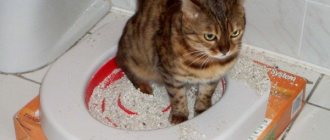Why toilet train a cat?
When you get a cat, you get a lot of trouble. One of the regular concerns of every owner of a furry pet is the constant removal of the tray and the purchase of litter. If everyone in the household works and spends little time at home, this causes the animal some discomfort. Everyone benefits from training a cat to go to the toilet on the toilet:
- you don’t need to keep track of the remaining filler at home;
- you no longer spend money on filler, on a new tray to replace the old one;
- a tray is not needed, which means it frees up space and is not visible to guests;
- You will no longer need to clean up after the cat;
- the characteristic odor disappears.
Once you have trained your cat to use the toilet, all you need to do is press the flush button.
Features of the method
Many cat owners, especially after watching numerous videos on the Internet, want their pet to be just as smart and neat. Of course, a cat’s ability to use a human toilet will solve several problems at once:
- space saving: trays are usually located in the bathroom or toilet. And most of them take up a lot of space. And if the room is of modest size, then every centimeter counts;
- saving money: a good quality tray and filler are quite expensive, and they are used up quite quickly. Therefore, using a toilet by a cat will reduce these costs to zero;
- cleanliness in the house: owners of long-haired fluffy cats are familiar with the situation with the adhesion of filler particles not only to the paws, but also to the tail and belly of the pet. In addition to making a mess, the litter can cause an allergic reaction not only in family members, but also in the animal itself;
- saving time: you do not have to clean and wash the tray, change the filler and carry out disinfection.
Of course, toilet training a cat requires time and patience, but nothing is impossible. Since cats are smart and quick-witted animals, most of which are highly trainable, this method will not seem too difficult to you. However, it is important to start training as early as possible. Young cats are easier to train and quickly learn what they need. A pet that has mastered the toilet will become a real source of pride for the whole family.
Who can be trained and who shouldn't
Almost any cat can be trained to use the toilet. However, there are certain restrictions. Who should not be toilet trained:
- cats leading a sedentary lifestyle and pregnant cats - because of their awkwardness;
- It is also better to leave nursing cats alone;
- older, sick or weakened cats should not be tormented by attempts to give up the tray;
- Kittens that are too small are not yet ready to go to the toilet; they are at risk of falling.
The optimal age for training a cat is 5-6 months. At this age, their psyche is still flexible enough to learn a new skill, and they are not too young to fall awkwardly.
Getting used to the new toilet
The final and most important stage is “weaning” the kitten from the litter box. At this stage, you need to make sure that the tray remains in place, but is inaccessible to the kitten. Seal the tray with adhesive tape crosswise so that the kitten cannot fit in there. And do not forget to leave a free space between the “inaccessible” tray and the rim of the toilet where the animal could recover. Already accustomed to going to the toilet in this exact place, the kitten will use the free space you leave for its intended purpose.
Another option for the final stage. Remove the tray completely, and place (hang) a plastic strip ten to fifteen centimeters wide with filler poured on it inside the toilet bowl. The kitten will be able to dig it, but not sit on the strip. And he will be forced to relieve himself while sitting on the rim of the toilet. They say that this option has a greater effect and is less painful for the animal.
Or you can try to do without filler on the tape. Just move the tray out of sight (and the newspapers there too) so that the smell that comes from it (no matter how well you wash the tray) does not provoke the cat to search. The animal will jump on the toilet, as usual and already as it is accustomed to - but there is no tray! And he is nowhere to be found! What's left for a smart pussy? Just do your business while sitting on the toilet.
Preliminary preparation
Preliminary preparation is needed in two cases:
- the cat is afraid to go to the toilet;
- the cat does not know how to use the litter box;
In the first case, accustom the animal to the toilet gradually. Pick him up and carry him inside, let him get comfortable. If you keep the door slightly open, the cat will gradually show interest in the room. When your pet can fearlessly go inside, accustom him to the sound of water flushing. To prevent the cat from being afraid, hold it in your arms. Toilet training begins only after the anxiety disappears.
In the second case, use the litter box training method. When this skill is mastered perfectly, move on to the next stage.
Moving to a new toilet
And now the kitten is already on it (on the toilet), is not afraid of anything, jumps all over the toilet like a young goat, but still relieves itself in the tray. And a logical question arises: how to accustom a kitten to the toilet as a tray?
The second stage is just the beginning of such “training”. At this stage, the tray moves onto the toilet seat. How to do it? Also gradually: on the first day, the tray is moved onto the toilet by one quarter (three quarters rest on a stack of newspapers). The next day, the tray should already be standing half on the toilet, half on newspapers. And if the kitten reacts calmly to all your manipulations and does not show dissatisfaction, then on the third day the tray is completely placed on the toilet. After placing the tray on the toilet seat, secure it (for example, with double-sided tape) so that it remains motionless as the kitten moves. And don't forget to keep the newspapers as far away from your pussy as possible. Otherwise, the kitty uses the very pile of newspapers as a toilet.
Training technique
When teaching your cat new things, be persistent and consistent. A special technique tested by many cat owners will help you achieve the desired result.
The technique does not require special devices. You can make do with improvised means - take a cat litter box and prepare old newspapers.
- The first step is to start moving the cat's litter box toward the toilet. Move slowly, a maximum of 3 centimeters per day, so that your pet does not become stressed by sudden changes.
- The second step is to start raising the tray higher when it is near the toilet and the animal does not express dissatisfaction. Every day, add several newspapers under the tray, up to a maximum of two centimeters. Be sure to pay attention to the stability of the tray, otherwise the process will take a lot of time if the pet falls and gets scared. A wobbly stack will cause discomfort in the cat, and he will ignore the new litter box. As a result, the animal should get used to the fact that the tray is now at the top.
- The third step is to place the tray on the toilet and the pet can jump on it. Now you remove the plastic parts and lid from the tray. The cat must understand that he needs to do his business in such a toilet. Make sure the structure is stable.
The third stage of habituation lasts the longest. You observe how the animal behaves and how it adapts to new conditions. It is very important not to rush here so as not to provoke stress. The cat will gradually get used to the new place. When he starts going to the toilet on the toilet, the tray is removed. It is advisable to get rid of it so that the cat does not find its old litter box by the smell.
Next, there are two rules to follow:
- provide constant access to the toilet - open the door slightly or provide a “cat window” at the bottom;
- keep the toilet lid up.
Toilet training system for cats. Set, simulator for accustoming a cat to the toilet
For the convenience of owners and animals, manufacturers of products for cats produce special systems for training cats to use the toilet on the toilet.
Their configurations may vary, but the principle remains the same: a device similar to an ordinary cat potty is gradually modified, turning into something similar to a toilet seat.
The most popular training systems due to their convenience are:
- Domakot
- Unicott
- Litter Kwitter
- CitiKitty Cat Toilet Training Kit
- VACA
Systems for toilet training a cat.
IMPORTANT: Such simulators cost a decent amount, 600 to 4000 rubles depending on the manufacturer.
Toilet training with the Litter Kwitter system.
Toilet training using this system in the early stages differs little from the one described above.
- A training tray with a solid bottom is filled with litter that the cat usually uses. The tray is placed near the toilet.
- Gradually raise the tray, leveling it in height with the toilet lid over the course of two weeks. At the same time, the filler is gradually changed to one that can be flushed down the toilet.
- Install the training system directly on the toilet. It still looks like a regular tray. When the cat confidently jumps on the toilet and goes to the potty, you need to replace the solid tray with a tray with a hole, if it is a Litter Kwitter system, go cut off the smallest ring in the center of the tray, if it is Domakot.
- After a couple of days, enlarge the hole in the center of the pan or replace the pan. Accordingly, pour less filler into the tray.
- Gradually increase the diameter of the hole in the tray to the diameter of the toilet bowl. Then you can remove the training tray completely. As a rule, training on the system after installing it on the toilet takes 10-14 days.
Toilet training with the DOMAKOT system.
The simplest simulator for training a cat to use the toilet is a plastic attachment with a small hole. It is installed on top of the bowl of the sanitary ware.
A simple simulator for training a cat to use the toilet.
The advantage of this type of design is that it is very ergonomic, so a small cat can use the toilet.
Training using a special pad
The task of toilet training is made easier by special pads. You can make such a device yourself by cutting out a mesh liner from the tray and adjusting it to the size of the toilet. By attaching the pad to the toilet, you gradually teach the cat to go to the toilet in a new place. It’s even easier to buy a ready-made toilet tray cover at a pet store. The models have different designs, but perform the same function.
The first stage of training is similar to that described above. The owner installs a tray on top of the toilet. The difference is that you don’t need to remove it suddenly afterwards.
It is convenient to use a special device with a hole cut inside. Every five days you trim the hole, making it larger. The cat will understand that it is forbidden to step into the center of the tray. When the hole accurately follows the contours of the circumference of the toilet, there will be no need for a cover. You take it off, and your pet goes to the toilet out of habit. This training method is suitable for small and young animals.
You can buy a whole set of pads of different sizes, then you won't have to trim the hole to make it bigger. Simply replacing them every five days is enough. Don't forget to pay attention to your pet's weight so that the pad can support it.
How to start training
The optimal age to start litter box training is 6–7 months. The kitten has already grown enough to move deftly and adequately assess obstacles, but its psyche is still quite flexible to assimilate new information and skills without resistance. Also, as a rule, by this age the pet has completely mastered the tray and uses it without failure.
If your pet is used to using a litter box without filler, then it will be much easier to train him. For those owners whose cats are accustomed to various types of litter, first you need to accustom the animal to an empty tray with a grid. This process must be carried out gradually, gradually reducing the amount of filler.
Some furry cats may refuse to go to the toilet in an empty tray, as their instincts force them to carefully “bury” their feces so that the smell is not picked up by a larger predator or potential prey. Of course, there may be protests on the part of the pet - he can relieve his needs elsewhere. In this case, if you do not want to retreat, you should start over.
Not all categories of pets can undergo this type of training. When learning, small kittens can harm themselves: fall off the toilet and get injured, or fall inside and choke. Exceptions also include pregnant and lactating females, sick adults and elderly animals. This method is not for those who work a lot and devote little time to their pet. It will be difficult to implement the process for those owners who have several pets.
If the cat does not fit or slips
You need to start by stopping cleaning the litter box. Because it becomes dirty there, clean cats will stop going there after 3 days and will sit and wait near it with a menacing look. Then the owner takes the cat in his arms and carries it to the training tray, because it is clean.
Literally after 5 days you can remove the old tray, the cat will already get used to the new place. But! When the cutouts on the training tray reach the end, many pets will protest using it because it is thin and slippery, and they are afraid to jump onto the toilet. Especially large and well-fed animals.
If this happens, then there is no other way out than to sacrifice the toilet LID . You need to purchase a 152 mm drill attachment and drill a hole in the lid, right in the center.
Next, to prevent the cat’s paws from sliding on the plastic cover, it is worth making it non-smooth in various ways. You can glue various dotted fabric or rubber shelves, circles, and squiggles. So that the cat can jump onto the lid more confidently and not be afraid of slipping.
Training cats and cats to use the toilet reduces not only the time for cleaning, but also the cost of litter. In addition, this is a way to keep the human seat clean, the only thing about this option is that you will have to get used to always closing the toilet lid for your pet.











